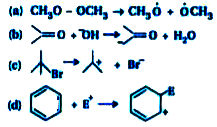For the following bond cleavages, use curved arrows to show the electron flow and classify each as homolysis or heterolysis. Identify the reactive intermediates produced in CH3−O−O−CH3→CH3−O+CH3OSolution in Malayalam
The correct Answer is:(##ANEPKECHE0XIC12E02031_S01##)
Step by step video, text & image solution for For the following bond cleavages, use curved arrows to show the electron flow and classify each as homolysis or heterolysis. Identify the reactive intermediates produced in CH_3-O-O-CH_3 rarr CH_3-O+CH_3O by Chemistry experts to help you in doubts & scoring excellent marks in Class 11 exams.
Updated on:21/07/2023Topper's Solved these Questions
Similar Questions
Write the names of isotopes of hydrogen. What is the mass ratio of these isotopes?
View SolutionCalculate the oxidation number of underlined element in the following compound:
HN––O3
View SolutionUsing the curved-arrow notation, show the formation of reactive intermediates when the following convalent bonds undergo heterolytic cleavage :
(a) CH3−S−CH3
(b) CH3−CN
( c) CH3−Cu .
View SolutionFor the following bond cleavages, use curved-arrow to show the electron flow and classify each as homolysis or heterolysis. Identify intermediate products as free radical, carbocation, and carbanion. (a) CH_3O - OCH_3 rarr CH_3 dot O+ dot O CH_3 .
View SolutionClassify each of the following as homolysis as homolysis or heterolysis. Identify the reaction intermediates produced , as free radical, carbocation and carbanion.
View SolutionFor the following bond cleavages, use curved arrows to show the electron flow and classify each as homolysis or heterolysis. Identify reactive intermediate produced during the fission.
View SolutionFor the given bond cleavages, use curved - arrows to show the electron flow and classify each as homolysis or heterolysis. Identify reactive intermediate produced as free radical, carbocation and carbanion. CH_(3)O-OCH_(3)rarrCH_(3)overset(*)(O)+overset(*)(O)CH_(3)
View SolutionColumn - I (A) CH_3-overset(O)overset(||)-O-overset(Ph)overset(|)underset(Ph)underset(|)-Phoverset(H^(oplus)//H_2O)to (B) CH_3-overset(CH_3)overset(|)underset(CH_3)underset(|)-overset(O)overset(||)C-o-Ph overset(H^(oplus)//H_2O)to (C ) CH_3-O- overset(CH_3)overset(|)underset(CH_3)underset(|)C-CH_3 overset(H^(oplus)//H_2O)to (D) CH_3-O-underset(CH_3)underset(|)CH-CH_3 overset(HI)to Column-II (P) Unimolecular (Q) Bimolecular (R) Alkyl oxygen bond cleavage (S) Acyl oxygen bond cleavage
View SolutionFor the following bond cleavages, use curved-arrows to show the electron flow and classify each as homolysis or heterolysis. Identify reactive intermediate produced as free radical, carbocation and carbanion. (a) CH_(3)O-OCH_(3)rarrCH_(3)overset(.)O+overset(.)(O)CH_(3) (b)
View SolutionCH_3-O-CH_3 IUPAC name is
View SolutionUsing the curved-arrow notation, show the formation of reactive intermediates when the following convalent bonds undergo heterolytic cleavage :
(a) CH3−S−CH3
(b) CH3−CN
( c) CH3−Cu .
View SolutionFor the following bond cleavages, use curved-arrow to show the electron flow and classify each as homolysis or heterolysis. Identify intermediate products as free radical, carbocation, and carbanion.
(a) CH3O−OCH3→CH3.O+.OCH3
 .
.
View SolutionWhich one in each of the following pairs is expected to exhibit hydrogen bonding together? CH_3- CH_2 -OH and CH_3 -O- CH_3
View SolutionFor the following bond cleavages, use curved arrows to show the electron flow and classify each as homolysis or heterolysis. Identify reactive intermediate produced as free radical, carbocation and carbanion (a) CH_(3)O- OCH_(3) rarr CH_(3) overset(.)(O) + overset(.)(O)CH_(3)
View SolutionFor the following bond cleavages, use curved arrows to show the electron flow and classify each as homolysis or heterolysis. Identify reactive intermediate produced as free radical, carbocation and carbanion
(a) CH3O−OCH3→CH3.O+.OCH3

View Solution
